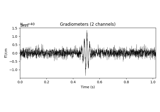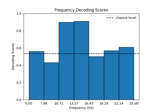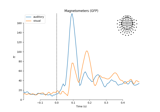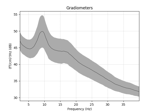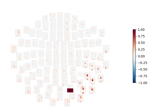mne.time_frequency.AverageTFR¶
-
class
mne.time_frequency.AverageTFR(info, data, times, freqs, nave, comment=None, method=None, verbose=None)[source]¶ Container for Time-Frequency data.
Can for example store induced power at sensor level or inter-trial coherence.
- Parameters
- info
Info The measurement info.
- data
ndarray, shape (n_channels, n_freqs, n_times) The data.
- times
ndarray, shape (n_times,) The time values in seconds.
- freqs
ndarray, shape (n_freqs,) The frequencies in Hz.
- nave
int The number of averaged TFRs.
- comment
str|None, defaultNone Comment on the data, e.g., the experimental condition.
- method
str|None, defaultNone Comment on the method used to compute the data, e.g., morlet wavelet.
- verbosebool,
str,int, orNone If not None, override default verbose level (see
mne.verbose()and Logging documentation for more). If used, it should be passed as a keyword-argument only.
- info
- Attributes
- infoinstance of
Info Measurement info.
ch_nameslistChannel names.
- nave
int Number of averaged epochs.
- data
ndarray, shape (n_channels, n_freqs, n_times) The data array.
- times
ndarray, shape (n_times,) The time values in seconds.
- freqs
ndarray, shape (n_freqs,) The frequencies in Hz.
- comment
str Comment on dataset. Can be the condition.
- method
str|None, defaultNone Comment on the method used to compute the data, e.g., morlet wavelet.
- infoinstance of
Methods
__add__(tfr)Add instances.
__contains__(ch_type)Check channel type membership.
__hash__()Hash the object.
__mul__(a)Multiply source instances.
__sub__(tfr)Subtract instances.
add_channels(add_list[, force_update_info])Append new channels to the instance.
apply_baseline(baseline[, mode, verbose])Baseline correct the data.
copy()Return a copy of the instance.
crop([tmin, tmax, fmin, fmax, include_tmax])Crop data to a given time interval in place.
drop_channels(ch_names)Drop channel(s).
get_channel_types([picks, unique, only_data_chs])Get a list of channel type for each channel.
Get a DigMontage from instance.
pick(picks[, exclude])Pick a subset of channels.
pick_channels(ch_names[, ordered])Pick some channels.
pick_types([meg, eeg, stim, eog, ecg, emg, …])Pick some channels by type and names.
plot([picks, baseline, mode, tmin, tmax, …])Plot TFRs as a two-dimensional image(s).
plot_joint([timefreqs, picks, baseline, …])Plot TFRs as a two-dimensional image with topomaps.
plot_topo([picks, baseline, mode, tmin, …])Plot TFRs in a topography with images.
plot_topomap([tmin, tmax, fmin, fmax, …])Plot topographic maps of time-frequency intervals of TFR data.
reorder_channels(ch_names)Reorder channels.
save(fname[, overwrite])Save TFR object to hdf5 file.
-
__contains__(ch_type)[source]¶ Check channel type membership.
- Parameters
- ch_type
str Channel type to check for. Can be e.g. ‘meg’, ‘eeg’, ‘stim’, etc.
- ch_type
- Returns
- inbool
Whether or not the instance contains the given channel type.
Examples
Channel type membership can be tested as:
>>> 'meg' in inst True >>> 'seeg' in inst False
-
add_channels(add_list, force_update_info=False)[source]¶ Append new channels to the instance.
- Parameters
- add_list
list A list of objects to append to self. Must contain all the same type as the current object.
- force_update_infobool
If True, force the info for objects to be appended to match the values in
self. This should generally only be used when adding stim channels for which important metadata won’t be overwritten.New in version 0.12.
- add_list
- Returns
See also
Notes
If
selfis a Raw instance that has been preloaded into anumpy.memmapinstance, the memmap will be resized.
-
apply_baseline(baseline, mode='mean', verbose=None)[source]¶ Baseline correct the data.
- Parameters
- baselinearray_like, shape (2,)
The time interval to apply rescaling / baseline correction. If None do not apply it. If baseline is (a, b) the interval is between “a (s)” and “b (s)”. If a is None the beginning of the data is used and if b is None then b is set to the end of the interval. If baseline is equal to (None, None) all the time interval is used.
- mode‘mean’ | ‘ratio’ | ‘logratio’ | ‘percent’ | ‘zscore’ | ‘zlogratio’
Perform baseline correction by
subtracting the mean of baseline values (‘mean’)
dividing by the mean of baseline values (‘ratio’)
dividing by the mean of baseline values and taking the log (‘logratio’)
subtracting the mean of baseline values followed by dividing by the mean of baseline values (‘percent’)
subtracting the mean of baseline values and dividing by the standard deviation of baseline values (‘zscore’)
dividing by the mean of baseline values, taking the log, and dividing by the standard deviation of log baseline values (‘zlogratio’)
- verbosebool,
str,int, orNone If not None, override default verbose level (see
mne.verbose()and Logging documentation for more). If used, it should be passed as a keyword-argument only. Defaults to self.verbose.
- Returns
- instinstance of
AverageTFR The modified instance.
- instinstance of
-
property
ch_names¶ Channel names.
-
property
compensation_grade¶ The current gradient compensation grade.
-
copy()[source]¶ Return a copy of the instance.
- Returns
- copyinstance of
EpochsTFR| instance ofAverageTFR A copy of the instance.
- copyinstance of
-
crop(tmin=None, tmax=None, fmin=None, fmax=None, include_tmax=True)[source]¶ Crop data to a given time interval in place.
- Parameters
- tmin
float|None Start time of selection in seconds.
- tmax
float|None End time of selection in seconds.
- fmin
float|None Lowest frequency of selection in Hz.
New in version 0.18.0.
- fmax
float|None Highest frequency of selection in Hz.
New in version 0.18.0.
- include_tmaxbool
If True (default), include tmax. If False, exclude tmax (similar to how Python indexing typically works).
New in version 0.19.
- tmin
- Returns
- instinstance of
AverageTFR The modified instance.
- instinstance of
-
drop_channels(ch_names)[source]¶ Drop channel(s).
- Parameters
- Returns
See also
Notes
New in version 0.9.0.
-
get_channel_types(picks=None, unique=False, only_data_chs=False)[source]¶ Get a list of channel type for each channel.
- Parameters
- picks
str|list|slice|None Channels to include. Slices and lists of integers will be interpreted as channel indices. In lists, channel type strings (e.g.,
['meg', 'eeg']) will pick channels of those types, channel name strings (e.g.,['MEG0111', 'MEG2623']will pick the given channels. Can also be the string values “all” to pick all channels, or “data” to pick data channels. None (default) will pick all channels.- uniquebool
Whether to return only unique channel types. Default is
False.- only_data_chsbool
Whether to ignore non-data channels. Default is
False.
- picks
- Returns
- channel_types
list The channel types.
- channel_types
-
get_montage()[source]¶ Get a DigMontage from instance.
- Returns
- montage
None|str|DigMontage A montage containing channel positions. If str or DigMontage is specified, the channel info will be updated with the channel positions. Default is None. See also the documentation of
mne.channels.DigMontagefor more information.
- montage
-
pick(picks, exclude=())[source]¶ Pick a subset of channels.
- Parameters
- picks
str|list|slice|None Channels to include. Slices and lists of integers will be interpreted as channel indices. In lists, channel type strings (e.g.,
['meg', 'eeg']) will pick channels of those types, channel name strings (e.g.,['MEG0111', 'MEG2623']will pick the given channels. Can also be the string values “all” to pick all channels, or “data” to pick data channels. None (default) will pick all channels.- exclude
list|str Set of channels to exclude, only used when picking based on types (e.g., exclude=”bads” when picks=”meg”).
- picks
- Returns
-
pick_channels(ch_names, ordered=False)[source]¶ Pick some channels.
- Parameters
- Returns
See also
Notes
The channel names given are assumed to be a set, i.e. the order does not matter. The original order of the channels is preserved. You can use
reorder_channelsto set channel order if necessary.New in version 0.9.0.
-
pick_types(meg=None, eeg=False, stim=False, eog=False, ecg=False, emg=False, ref_meg='auto', misc=False, resp=False, chpi=False, exci=False, ias=False, syst=False, seeg=False, dipole=False, gof=False, bio=False, ecog=False, fnirs=False, csd=False, include=(), exclude='bads', selection=None, verbose=None)[source]¶ Pick some channels by type and names.
- Parameters
- megbool |
str If True include MEG channels. If string it can be ‘mag’, ‘grad’, ‘planar1’ or ‘planar2’ to select only magnetometers, all gradiometers, or a specific type of gradiometer.
- eegbool
If True include EEG channels.
- stimbool
If True include stimulus channels.
- eogbool
If True include EOG channels.
- ecgbool
If True include ECG channels.
- emgbool
If True include EMG channels.
- ref_megbool |
str If True include CTF / 4D reference channels. If ‘auto’, reference channels are included if compensations are present and
megis not False. Can also be the string options for themegparameter.- miscbool
If True include miscellaneous analog channels.
- respbool
If True include response-trigger channel. For some MEG systems this is separate from the stim channel.
- chpibool
If True include continuous HPI coil channels.
- excibool
Flux excitation channel used to be a stimulus channel.
- iasbool
Internal Active Shielding data (maybe on Triux only).
- systbool
System status channel information (on Triux systems only).
- seegbool
Stereotactic EEG channels.
- dipolebool
Dipole time course channels.
- gofbool
Dipole goodness of fit channels.
- biobool
Bio channels.
- ecogbool
Electrocorticography channels.
- fnirsbool |
str Functional near-infrared spectroscopy channels. If True include all fNIRS channels. If False (default) include none. If string it can be ‘hbo’ (to include channels measuring oxyhemoglobin) or ‘hbr’ (to include channels measuring deoxyhemoglobin).
- csdbool
EEG-CSD channels.
- include
listofstr List of additional channels to include. If empty do not include any.
- exclude
listofstr|str List of channels to exclude. If ‘bads’ (default), exclude channels in
info['bads'].- selection
listofstr Restrict sensor channels (MEG, EEG) to this list of channel names.
- verbosebool,
str,int, orNone If not None, override default verbose level (see
mne.verbose()and Logging documentation for more). If used, it should be passed as a keyword-argument only. Defaults to self.verbose.
- megbool |
- Returns
See also
Notes
New in version 0.9.0.
-
plot(picks=None, baseline=None, mode='mean', tmin=None, tmax=None, fmin=None, fmax=None, vmin=None, vmax=None, cmap='RdBu_r', dB=False, colorbar=True, show=True, title=None, axes=None, layout=None, yscale='auto', mask=None, mask_style=None, mask_cmap='Greys', mask_alpha=0.1, combine=None, exclude=[], verbose=None)[source]¶ Plot TFRs as a two-dimensional image(s).
- Parameters
- picks
str|list|slice|None Channels to include. Slices and lists of integers will be interpreted as channel indices. In lists, channel type strings (e.g.,
['meg', 'eeg']) will pick channels of those types, channel name strings (e.g.,['MEG0111', 'MEG2623']will pick the given channels. Can also be the string values “all” to pick all channels, or “data” to pick data channels. None (default) will pick good data channels.- baseline
None(default) ortuple, shape (2,) The time interval to apply baseline correction. If None do not apply it. If baseline is (a, b) the interval is between “a (s)” and “b (s)”. If a is None the beginning of the data is used and if b is None then b is set to the end of the interval. If baseline is equal to (None, None) all the time interval is used.
- mode‘mean’ | ‘ratio’ | ‘logratio’ | ‘percent’ | ‘zscore’ | ‘zlogratio’
Perform baseline correction by
subtracting the mean of baseline values (‘mean’)
dividing by the mean of baseline values (‘ratio’)
dividing by the mean of baseline values and taking the log (‘logratio’)
subtracting the mean of baseline values followed by dividing by the mean of baseline values (‘percent’)
subtracting the mean of baseline values and dividing by the standard deviation of baseline values (‘zscore’)
dividing by the mean of baseline values, taking the log, and dividing by the standard deviation of log baseline values (‘zlogratio’)
- tmin
None|float The first time instant to display. If None the first time point available is used.
- tmax
None|float The last time instant to display. If None the last time point available is used.
- fmin
None|float The first frequency to display. If None the first frequency available is used.
- fmax
None|float The last frequency to display. If None the last frequency available is used.
- vmin
float|None The minimum value an the color scale. If vmin is None, the data minimum value is used.
- vmax
float|None The maximum value an the color scale. If vmax is None, the data maximum value is used.
- cmapmatplotlib colormap | ‘interactive’ | (colormap, bool)
The colormap to use. If tuple, the first value indicates the colormap to use and the second value is a boolean defining interactivity. In interactive mode the colors are adjustable by clicking and dragging the colorbar with left and right mouse button. Left mouse button moves the scale up and down and right mouse button adjusts the range. Hitting space bar resets the range. Up and down arrows can be used to change the colormap. If ‘interactive’, translates to (‘RdBu_r’, True). Defaults to ‘RdBu_r’.
Warning
Interactive mode works smoothly only for a small amount of images.
- dBbool
If True, 10*log10 is applied to the data to get dB.
- colorbarbool
If true, colorbar will be added to the plot. For user defined axes, the colorbar cannot be drawn. Defaults to True.
- showbool
Call pyplot.show() at the end.
- title
str| ‘auto’ |None String for title. Defaults to None (blank/no title). If ‘auto’, automatically create a title that lists up to 6 of the channels used in the figure.
- axesinstance of
Axes|list|None The axes to plot to. If list, the list must be a list of Axes of the same length as the number of channels. If instance of Axes, there must be only one channel plotted.
- layout
Layout|None Layout instance specifying sensor positions. Used for interactive plotting of topographies on rectangle selection. If possible, the correct layout is inferred from the data.
- yscale‘auto’ (default) | ‘linear’ | ‘log’
The scale of y (frequency) axis. ‘linear’ gives linear y axis, ‘log’ leads to log-spaced y axis and ‘auto’ detects if frequencies are log-spaced and only then sets the y axis to ‘log’.
New in version 0.14.0.
- mask
ndarray|None An array of booleans of the same shape as the data. Entries of the data that correspond to False in the mask are plotted transparently. Useful for, e.g., masking for statistical significance.
New in version 0.16.0.
- mask_style
None| ‘both’ | ‘contour’ | ‘mask’ If
maskis not None: if'contour', a contour line is drawn around the masked areas (Trueinmask). If'mask', entries notTrueinmaskare shown transparently. If'both', both a contour and transparency are used. IfNone, defaults to'both'ifmaskis not None, and is ignored otherwise.New in version 0.17.
- mask_cmapmatplotlib colormap | (colormap, bool) | ‘interactive’
The colormap chosen for masked parts of the image (see below), if
maskis notNone. If None,cmapis reused. Defaults to'Greys'. Not interactive. Otherwise, ascmap.New in version 0.17.
- mask_alpha
float A float between 0 and 1. If
maskis not None, this sets the alpha level (degree of transparency) for the masked-out segments. I.e., if 0, masked-out segments are not visible at all. Defaults to 0.1.New in version 0.16.0.
- combine‘mean’ | ‘rms’ |
None Type of aggregation to perform across selected channels. If None, plot one figure per selected channel.
- exclude
listofstr| ‘bads’ Channels names to exclude from being shown. If ‘bads’, the bad channels are excluded. Defaults to an empty list.
- verbosebool,
str,int, orNone If not None, override default verbose level (see
mne.verbose()and Logging documentation for more). If used, it should be passed as a keyword-argument only. Defaults to self.verbose.
- picks
- Returns
- fig
matplotlib.figure.Figure The figure containing the topography.
- fig
Examples using
plot:
-
plot_joint(timefreqs=None, picks=None, baseline=None, mode='mean', tmin=None, tmax=None, fmin=None, fmax=None, vmin=None, vmax=None, cmap='RdBu_r', dB=False, colorbar=True, show=True, title=None, yscale='auto', combine='mean', exclude=[], topomap_args=None, image_args=None, verbose=None)[source]¶ Plot TFRs as a two-dimensional image with topomaps.
- Parameters
- timefreqs
None|listoftuple|dictoftuple The time-frequency point(s) for which topomaps will be plotted. See Notes.
- picks
str|list|slice|None Channels to include. Slices and lists of integers will be interpreted as channel indices. In lists, channel type strings (e.g.,
['meg', 'eeg']) will pick channels of those types, channel name strings (e.g.,['MEG0111', 'MEG2623']will pick the given channels. Can also be the string values “all” to pick all channels, or “data” to pick data channels. None (default) will pick good data channels.- baseline
None(default) ortupleof length 2 The time interval to apply baseline correction. If None do not apply it. If baseline is (a, b) the interval is between “a (s)” and “b (s)”. If a is None, the beginning of the data is used. If b is None, then b is set to the end of the interval. If baseline is equal to (None, None), the entire time interval is used.
- mode
None|str If str, must be one of ‘ratio’, ‘zscore’, ‘mean’, ‘percent’, ‘logratio’ and ‘zlogratio’. Do baseline correction with ratio (power is divided by mean power during baseline) or zscore (power is divided by standard deviation of power during baseline after subtracting the mean, power = [power - mean(power_baseline)] / std(power_baseline)), mean simply subtracts the mean power, percent is the same as applying ratio then mean, logratio is the same as mean but then rendered in log-scale, zlogratio is the same as zscore but data is rendered in log-scale first. If None no baseline correction is applied.
- tmin
None|float The first time instant to display. If None the first time point available is used.
- tmax
None|float The last time instant to display. If None the last time point available is used.
- fmin
None|float The first frequency to display. If None the first frequency available is used.
- fmax
None|float The last frequency to display. If None the last frequency available is used.
- vmin
float|None The minimum value of the color scale for the image (for topomaps, see
topomap_args). If vmin is None, the data absolute minimum value is used.- vmax
float|None The maximum value of the color scale for the image (for topomaps, see
topomap_args). If vmax is None, the data absolute maximum value is used.- cmapmatplotlib colormap
The colormap to use.
- dBbool
If True, 10*log10 is applied to the data to get dB.
- colorbarbool
If true, colorbar will be added to the plot (relating to the topomaps). For user defined axes, the colorbar cannot be drawn. Defaults to True.
- showbool
Call pyplot.show() at the end.
- title
str|None String for title. Defaults to None (blank/no title).
- yscale‘auto’ (default) | ‘linear’ | ‘log’
The scale of y (frequency) axis. ‘linear’ gives linear y axis, ‘log’ leads to log-spaced y axis and ‘auto’ detects if frequencies are log-spaced and only then sets the y axis to ‘log’.
- combine‘mean’ | ‘rms’
Type of aggregation to perform across selected channels.
- exclude
listofstr| ‘bads’ Channels names to exclude from being shown. If ‘bads’, the bad channels are excluded. Defaults to an empty list, i.e.,
[].- topomap_args
None|dict A dict of
kwargsthat are forwarded tomne.viz.plot_topomap()to style the topomaps.axesandshoware ignored. Iftimesis not in this dict, automatic peak detection is used. Beyond that, ifNone, no customizable arguments will be passed. Defaults toNone.- image_args
None|dict A dict of
kwargsthat are forwarded toAverageTFR.plot()to style the image.axesandshoware ignored. Beyond that, ifNone, no customizable arguments will be passed. Defaults toNone.- verbosebool,
str,int, orNone If not None, override default verbose level (see
mne.verbose()and Logging documentation for more). If used, it should be passed as a keyword-argument only. Defaults to self.verbose.
- timefreqs
- Returns
- fig
matplotlib.figure.Figure The figure containing the topography.
- fig
Notes
timefreqshas three different modes: tuples, dicts, and auto. For (list of) tuple(s) mode, each tuple defines a pair (time, frequency) in s and Hz on the TFR plot. For example, to look at 10 Hz activity 1 second into the epoch and 3 Hz activity 300 msec into the epoch,timefreqs=((1, 10), (.3, 3))
If provided as a dictionary, (time, frequency) tuples are keys and (time_window, frequency_window) tuples are the values - indicating the width of the windows (centered on the time and frequency indicated by the key) to be averaged over. For example,
timefreqs={(1, 10): (0.1, 2)}
would translate into a window that spans 0.95 to 1.05 seconds, as well as 9 to 11 Hz. If None, a single topomap will be plotted at the absolute peak across the time-frequency representation.
New in version 0.16.0.
Examples using
plot_joint:
-
plot_topo(picks=None, baseline=None, mode='mean', tmin=None, tmax=None, fmin=None, fmax=None, vmin=None, vmax=None, layout=None, cmap='RdBu_r', title=None, dB=False, colorbar=True, layout_scale=0.945, show=True, border='none', fig_facecolor='k', fig_background=None, font_color='w', yscale='auto', verbose=None)[source]¶ Plot TFRs in a topography with images.
- Parameters
- picks
str|list|slice|None Channels to include. Slices and lists of integers will be interpreted as channel indices. In lists, channel type strings (e.g.,
['meg', 'eeg']) will pick channels of those types, channel name strings (e.g.,['MEG0111', 'MEG2623']will pick the given channels. Can also be the string values “all” to pick all channels, or “data” to pick data channels. None (default) will pick good data channels.- baseline
None(default) ortupleof length 2 The time interval to apply baseline correction. If None do not apply it. If baseline is (a, b) the interval is between “a (s)” and “b (s)”. If a is None the beginning of the data is used and if b is None then b is set to the end of the interval. If baseline is equal to (None, None) all the time interval is used.
- mode‘mean’ | ‘ratio’ | ‘logratio’ | ‘percent’ | ‘zscore’ | ‘zlogratio’
Perform baseline correction by
subtracting the mean of baseline values (‘mean’)
dividing by the mean of baseline values (‘ratio’)
dividing by the mean of baseline values and taking the log (‘logratio’)
subtracting the mean of baseline values followed by dividing by the mean of baseline values (‘percent’)
subtracting the mean of baseline values and dividing by the standard deviation of baseline values (‘zscore’)
dividing by the mean of baseline values, taking the log, and dividing by the standard deviation of log baseline values (‘zlogratio’)
- tmin
None|float The first time instant to display. If None the first time point available is used.
- tmax
None|float The last time instant to display. If None the last time point available is used.
- fmin
None|float The first frequency to display. If None the first frequency available is used.
- fmax
None|float The last frequency to display. If None the last frequency available is used.
- vmin
float|None The minimum value of the color scale. If vmin is None, the data minimum value is used.
- vmax
float|None The maximum value of the color scale. If vmax is None, the data maximum value is used.
- layout
Layout|None Layout instance specifying sensor positions. If possible, the correct layout is inferred from the data.
- cmapmatplotlib colormap |
str The colormap to use. Defaults to ‘RdBu_r’.
- title
str Title of the figure.
- dBbool
If True, 10*log10 is applied to the data to get dB.
- colorbarbool
If true, colorbar will be added to the plot.
- layout_scale
float Scaling factor for adjusting the relative size of the layout on the canvas.
- showbool
Call pyplot.show() at the end.
- border
str Matplotlib borders style to be used for each sensor plot.
- fig_facecolorcolor
The figure face color. Defaults to black.
- fig_background
None|array A background image for the figure. This must be a valid input to
matplotlib.pyplot.imshow. Defaults to None.- font_colorcolor
The color of tick labels in the colorbar. Defaults to white.
- yscale‘auto’ (default) | ‘linear’ | ‘log’
The scale of y (frequency) axis. ‘linear’ gives linear y axis, ‘log’ leads to log-spaced y axis and ‘auto’ detects if frequencies are log-spaced and only then sets the y axis to ‘log’.
- verbosebool,
str,int, orNone If not None, override default verbose level (see
mne.verbose()and Logging documentation for more). If used, it should be passed as a keyword-argument only.
- picks
- Returns
- fig
matplotlib.figure.Figure The figure containing the topography.
- fig
Examples using
plot_topo:
-
plot_topomap(tmin=None, tmax=None, fmin=None, fmax=None, ch_type=None, baseline=None, mode='mean', vmin=None, vmax=None, cmap=None, sensors=True, colorbar=True, unit=None, res=64, size=2, cbar_fmt='%1.1e', show_names=False, title=None, axes=None, show=True, outlines='head', contours=6, sphere=None)[source]¶ Plot topographic maps of time-frequency intervals of TFR data.
- Parameters
- tmin
None|float The first time instant to display. If None the first time point available is used.
- tmax
None|float The last time instant to display. If None the last time point available is used.
- fmin
None|float The first frequency to display. If None the first frequency available is used.
- fmax
None|float The last frequency to display. If None the last frequency available is used.
- ch_type‘mag’ | ‘grad’ | ‘planar1’ | ‘planar2’ | ‘eeg’ |
None The channel type to plot. For ‘grad’, the gradiometers are collected in pairs and the RMS for each pair is plotted. If None, then first available channel type from order given above is used. Defaults to None.
- baseline
tupleorlistof length 2 The time interval to apply rescaling / baseline correction. If None do not apply it. If baseline is (a, b) the interval is between “a (s)” and “b (s)”. If a is None the beginning of the data is used and if b is None then b is set to the end of the interval. If baseline is equal to (None, None) all the time interval is used.
- mode‘mean’ | ‘ratio’ | ‘logratio’ | ‘percent’ | ‘zscore’ | ‘zlogratio’
Perform baseline correction by
subtracting the mean of baseline values (‘mean’)
dividing by the mean of baseline values (‘ratio’)
dividing by the mean of baseline values and taking the log (‘logratio’)
subtracting the mean of baseline values followed by dividing by the mean of baseline values (‘percent’)
subtracting the mean of baseline values and dividing by the standard deviation of baseline values (‘zscore’)
dividing by the mean of baseline values, taking the log, and dividing by the standard deviation of log baseline values (‘zlogratio’)
- vmin
float|callable()|None The value specifying the lower bound of the color range. If None, and vmax is None, -vmax is used. Else np.min(data) or in case data contains only positive values 0. If callable, the output equals vmin(data). Defaults to None.
- vmax
float|callable()|None The value specifying the upper bound of the color range. If None, the maximum value is used. If callable, the output equals vmax(data). Defaults to None.
- cmapmatplotlib colormap | (colormap, bool) | ‘interactive’ |
None Colormap to use. If tuple, the first value indicates the colormap to use and the second value is a boolean defining interactivity. In interactive mode the colors are adjustable by clicking and dragging the colorbar with left and right mouse button. Left mouse button moves the scale up and down and right mouse button adjusts the range. Hitting space bar resets the range. Up and down arrows can be used to change the colormap. If None (default), ‘Reds’ is used for all positive data, otherwise defaults to ‘RdBu_r’. If ‘interactive’, translates to (None, True).
- sensorsbool |
str Add markers for sensor locations to the plot. Accepts matplotlib plot format string (e.g., ‘r+’ for red plusses). If True, a circle will be used (via .add_artist). Defaults to True.
- colorbarbool
Plot a colorbar.
- unit
dict|str|None The unit of the channel type used for colorbar label. If scale is None the unit is automatically determined.
- res
int The resolution of the topomap image (n pixels along each side).
- size
float Side length per topomap in inches.
- cbar_fmt
str String format for colorbar values.
- show_namesbool |
callable() If True, show channel names on top of the map. If a callable is passed, channel names will be formatted using the callable; e.g., to delete the prefix ‘MEG ‘ from all channel names, pass the function lambda x: x.replace(‘MEG ‘, ‘’). If
maskis not None, only significant sensors will be shown.- title
str|None Title. If None (default), no title is displayed.
- axesinstance of
Axes|None The axes to plot to. If None the axes is defined automatically.
- showbool
Call pyplot.show() at the end.
- outlines‘head’ | ‘skirt’ |
dict|None The outlines to be drawn. If ‘head’, the default head scheme will be drawn. If ‘skirt’ the head scheme will be drawn, but sensors are allowed to be plotted outside of the head circle. If dict, each key refers to a tuple of x and y positions, the values in ‘mask_pos’ will serve as image mask. Alternatively, a matplotlib patch object can be passed for advanced masking options, either directly or as a function that returns patches (required for multi-axis plots). If None, nothing will be drawn. Defaults to ‘head’.
- contours
int|arrayoffloat The number of contour lines to draw. If 0, no contours will be drawn. When an integer, matplotlib ticker locator is used to find suitable values for the contour thresholds (may sometimes be inaccurate, use array for accuracy). If an array, the values represent the levels for the contours. If colorbar=True, the ticks in colorbar correspond to the contour levels. Defaults to 6.
- sphere
float| array_like |str|None The sphere parameters to use for the cartoon head. Can be array-like of shape (4,) to give the X/Y/Z origin and radius in meters, or a single float to give the radius (origin assumed 0, 0, 0). Can also be a spherical ConductorModel, which will use the origin and radius. Can be “auto” to use a digitization-based fit. Can also be None (default) to use ‘auto’ when enough extra digitization points are available, and 0.095 otherwise. Currently the head radius does not affect plotting.
New in version 0.20.
- tmin
- Returns
- fig
matplotlib.figure.Figure The figure containing the topography.
- fig
Examples using
plot_topomap:
